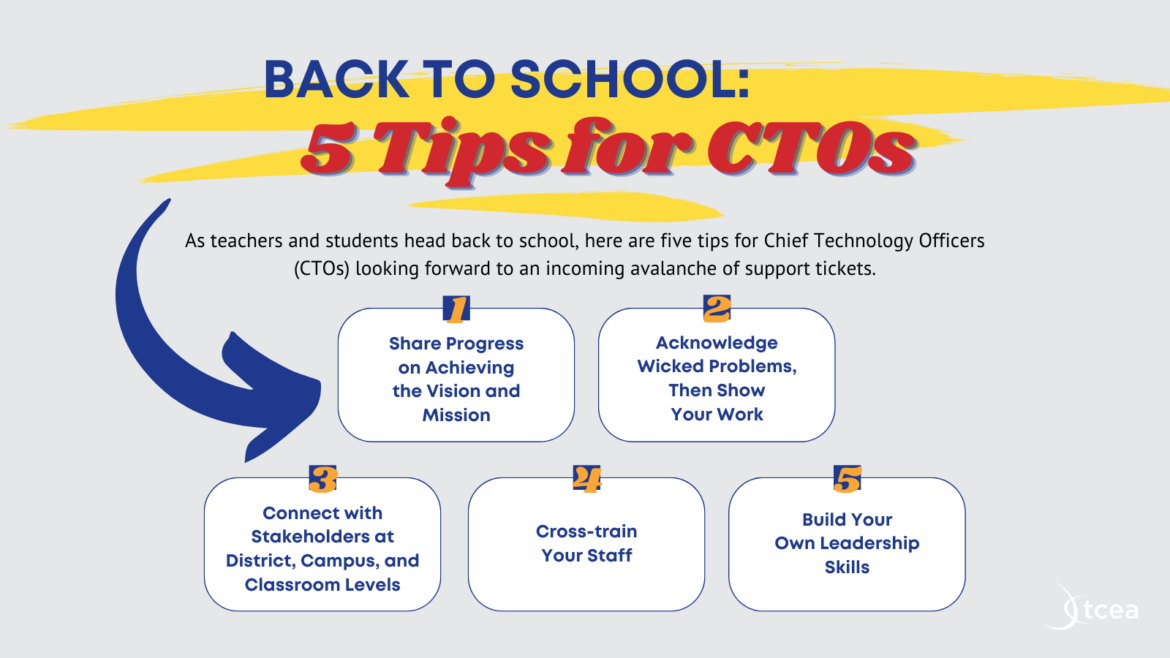As teachers and students head back to school, here are five tips for Chief Technology Officers (CTOs) looking forward to an incoming avalanche of support tickets. Each new ticket begs the question, “What did we miss fixing or doing this summer?” Just as the tide of trouble tickets ebbs in time, so do the critical relationships a CTO must maintain. New principals and central office staff challenge the status quo of previous, well-constructed relationships. In this blog entry, join me as we explore relationship-building tips for CTOs.
Tip #1 – Share Progress on Achieving the Vision and Mission
As a CTO, it’s easy to focus on the boxes and wires side of your work. When returning from a long summer break, you will need to remind everyone of what the district technology vision is. Then, show in measurable steps (including pictures and audio/video interviews with campus/district staff) how you are achieving those goals. This can be as simple as taking the top five trouble tickets at each campus and then explaining how they have been resolved in alignment to organization goals (e.g. strategic goals for technology). Remember to begin with the the problems (it’s best to have a teacher or principal explain it), then share what the technology department did.
Tip #2 – Acknowledge Wicked Problems, Then Show Your Work
Everyone knows that wicked problems, problems that persist in spite of our best efforts, exist. The challenge is what have you done to solve those problems. These are different than problems featured in Tip #1. For example, a trouble ticket for setting up a new computer lab or deploying a Chromebook cart in time for the new school year is a temporary problem. A wicked problem may be that power poles providing electricity to computer labs were never put in place. Thus, each year, teachers who want to use those labs are limited in the total devices that go into a space because electricity is not available.
Read the Solving Wicked Problems series: How do you get things done in your school district? What happens when you encounter wicked technology problems? Read this three-part series on how to engage administration and leaders who control the budget to obtain critical funding to meet the needs of the organization.
Another wicked problem may be that a campus lacks sufficient wireless access points. In the past, the campus relied on desktops and there are sufficient network drops, so everything was fine. As all students and staff receive Chromebooks, iPads, or laptops however, the majority of the network traffic shifts from wired to wireless. Show your work in assessing the situation, ordering wireless access points (WAPs), configuring, and then deploying them. Show technicians on ladders hanging the WAPs from the ceiling or configuring their use in the network closet. A simple video or photo slideshow with explanations can inform campus staff of what the technology department has done on their behalf.
Tip #3 – Connect with Stakeholders at District, Campus, and Classroom Levels

“Run to the resistors,” David Truss (technology administrator and principal) said to me once. This means embrace the views of those who resist change rather than shut it down. You can connect with stakeholders in simple ways. One approach that someone introduced me to involved quick face-to-face conversations. In each conversation, ask for three wishes and a star.
Listen to the Project Management Fundamentals presentation: It is an audio summary of a presentation shared at the Texas CTO Clinic in the summer, 2018.
The three wishes represent areas of potential growth that need to be addressed. You can capture these ideas, group them, and organize them by priority and funding. When you have a list, you can share this with other stakeholders at the district level. These may become your to-do items for the new year.
The star represents what the technology department is doing well. It is a subjective choice on the part of the stakeholder. It helps you appreciate what the stakeholder values in your department’s work. Post these stars in a public space, not just in the technology department. Each is a cause for celebration that all should be made aware of.
Tip #4 – Cross-train Your Staff
The beginning of the year is hardly the time to start cross-training efforts. It is instead the time to keep track of problems that arise that challenge the expertise of your technical and network staff. Back-to-school efforts often involve all staff in team-building endeavors. Make sure that your department’s culture will flourish beneath these district start of the year activities rather than leave staff muttering angrily. Renew again your collective commitment to work as a team and focus on teamwork. Avoid the tell-tale signs of a failed team:
- A team of all-stars who compete against each other for success, praise, and reward
- Individuals who are quick to re-assign trouble tickets to others because they prefer different work
- Individuals who hold all the usernames and passwords to a particular program
Building a culture of cross-training, engaging in team-building, and making a note of growth areas can define the depth of your team’s success.
Tip #5 – Build Your Own Leadership Skills
“Core leadership competencies matter more than subject matter expertise. An ignorant person with leadership skills goes further than an expert who can’t lead,” says Dan Rockwell (Leadership Freak). You may be an expert at networking, but if you lack customer service skills, you’ll soon be unemployed. As the people you serve begin to return to school, get back to the basics of customer service and leadership. Some tips for you include:
- Meet people face to face, building authentic relationships with anyone and everyone. You never know from whom or what situation you may learn something to assist and grow.
- Never miss an opportunity to listen and share solutions that matter to those you serve.
- Start a book study, article review, or a read and reflect opportunity for different stakeholder groups.
In each situation, hone your core leadership skills. Some describe these as inspiring or motivating others. Practice honesty and integrity, analyze and solve problems, and push for tangible results.

